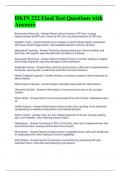HKIN 222 Final Test Questions with
Answers
Boutonniere Deformity - Answer-Result of blunt trauma to PIP joint, causing
hyperextension at MCP joint, flexion at PIP joint, and hyperextension at DIP joint.
Ganglion Cysts - Answer-Benign tumor masses on wrist's dorsal aspect, associated
with tissue sheath degeneration, often palpable between extensor tendons.
Metacarpal Fractures - Answer-Fractures causing severe pain, dorsal swelling, and
deformity, with specific types like Bennett's and Boxer's fractures.
Subungual Hematoma - Answer-Result of direct trauma to nail bed, leading to trapped
blood under fingernail, requiring drainage to relieve pressure.
Scaphoid Fracture - Answer-Most common carpal fracture, often due to hyperextension
during fall, causing pain in anatomical snuff box and wrist extension.
Medial Collateral Ligament - Answer-Anterior, transverse, posterior fibers important for
elbow stability
Elbow Flexion Muscles - Answer-Biceps, brachialis responsible for elbow flexion
Olecranon Bursitis - Answer-Inflammation of olecranon bursa due to fall, constant
irritation
Elbow Strain - Answer-Result of overcoming large force with muscle, inadequate warm-
up
Colles Fracture - Answer-Distal forearm fracture near wrist, resulting in fork deformity,
necessitating immediate immobilization and medical attention.
Skier's Thumb - Answer-Injury to ulnar collateral ligament of thumb, causing swelling,
pain, and instability, often requiring surgical repair.
Dislocations - Answer-Commonly at PIP or DIP joints, often due to hyperextension and
axial compression, causing obvious deformity and pain.
Wrist Sprain - Answer-Result of single trauma or repeated stress, with point tenderness
on radiocarpal joint, often leading to chronic instabilities.
Wrist Strains - Answer-Result of overload or overstretching, presenting with pain,
restricted motion, and often accompanying wrist sprains.
, Carpal Tunnel Syndrome - Answer-Compression of median nerve in wrist's carpal
tunnel, leading to night pain, numbness, and decreased grip strength.
Shoulder Complex Mobility - Answer-Allows extreme mobility but little stability, prone to
injury
Sports-related Shoulder Injuries - Answer-Involved in 8-13% of sports injuries, common
in overhead activities
Glenoid Labrum - Answer-Narrow fibrocartilage rim deepening the glenoid fossa
Rotator Cuff Muscles - Answer-Supraspinatus, Infraspinatus, Teres minor,
Subscapularis
Shoulder Dislocation Symptoms - Answer-Intense pain, tingling, numbness, held in
slight abduction
AC Sprain - Answer-Weak AC joint, common in sports, Rx involves NSAIDs,
immobilization
Impingement Syndrome - Answer-Chronic condition from overhead activity damaging
shoulder tissues
Rotator Cuff Tendinitis - Answer-Result of repetitive microtraumas, may lead to
impingement
Clavicular Fractures - Answer-Highly susceptible to compressive forces, Rx with figure 8
brace
Bicipital Tendon Injuries - Answer-Common in overhead movements, pain over bicipital
groove
Elbow Dislocation Symptoms - Answer-Severe pain, cracking, swelling, obvious
deformity, inability to move
Carrying Angle of Elbow - Answer-Angle between humerus and ulna allowing forearm to
angle away
Elbow Sprain - Answer-Result of fall on extended arm, valgus/varus force, or repetitive
force
Medial Epicondylitis - Answer-Repetitive motions causing strain on flexor muscles, ulnar
nerve
Medial Epicondyle Swelling - Answer-Swelling at the inner elbow bony prominence




